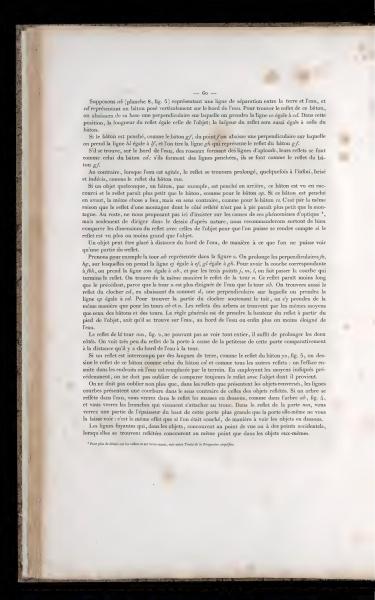The text explains methods to determine the reflection of objects like sticks and towers on water, considering their position and orientation. It provides detailed instructions on how to calculate the length and direction of reflections, using perpendiculars and comparing sizes. The text includes notes on perspective and optical phenomena related to reflections.
--- 60 ---
Let's consider ab (plate 8, fig. 5) as a line separating the earth and water, and cd as a stick placed vertically at the edge of the water. To find the reflection of this stick, we lower a perpendicular from its base on which we take the line ce equal to cd. In this position, the length of the reflection equals that of the object; the width of the reflection will also equal that of the stick.
If the stick is tilted, like the stick ef, from point f we lower a perpendicular on which we take the line hf equal to fg, and we draw the line gh which represents the reflection of the stick ef.
If there are reeds at the edge of the water forming vertical lines, their reflections are made like the stick cd; if they form inclined lines, they are made like the reflection of the stick ef.
On the other hand, when the water is disturbed, the reflection will be elongated, sometimes infinitely, broken and unclear, like the reflection of the stick mn.
If an object, a stick for example, is leaning backward, this stick is seen in foreshortening and the reflection appears smaller than the stick, like for the stick op. If this stick is leaning forward, the same thing happens, but in the opposite sense, as with the stick rs. It is for the same reason that the reflection of a mountain whose reflected side is not steep appears smaller than the mountain. As we do not propose here to dwell on the causes of these optical phenomena*, but only to guide in drawing from nature, we will especially recommend carefully comparing the dimensions of the reflection with those of the object so that one can understand whether the reflection is larger or smaller than the object.
An object can be placed at a distance from the edge of the water, so that one can only see part of the reflection.
Let's take for example the tower ab represented in figure 0. We extend the perpendiculars, hg, on which we take the line eg equal to fg, and gh equal to gh. To have the corresponding curve to fgh, we take the line em equal to ab, and through the three points j, m, n pass the curve that completes the reflection. We find the same way the reflection of the tower n. This reflection appears shorter than the previous one, because the tower n is further away from the water than the tower ab. We will also find the reflection of the bell tower cd, by lowering from the top of d, a perpendicular on which we take the line eg equal to cd. To find the part of the bell tower supporting the roof, we do so the same way as for the towers ab and n. The reflections of the trees are found by the same means as those of sticks and towers. The general rule is to take the height of the object from the foot of the object, whether it is on the water, at the edge of the water, or finally more or less distant from the water.
The reflection of the tower mn, fig. 2, not being able to be seen completely, it is enough to extend the two sides. Very little of the reflection of the door is seen due to the smallness of this door compared to the distance from the edge of the water to the tower.
If a reflection is interrupted by its land lengths, as the reflection of stick yz, fig. 5, we draw the reflection of this stick like that of the stick cd and like all other reflections: it is then erased in places where the water is replaced by the land. By using the means indicated previously, one must not forget to always compare the reflection with the object from which it comes.
One must also not forget that, in the reflections presented by inverted objects, the curved lines show a curvature in the opposite direction to those of the reflected objects. If a tree is reflected in water, you will see in the reflection the masses below, as in the tree ab, fig. 4, and you will see the branches that come to attach to the trunk. In the reflection of the door mn, you will see part of the thickness of the top of this door larger than the door itself shows you: it is the same effect as if one were lying down to see the objects from below.
The fleeing lines which, in the objects, converge at the point of view or at accidental points, when they are reflected converge at the same point as in the objects themselves.
* For more details on reflections and their causes, see our Treatise on Simplified Perspective.
Translation Notes
- "foreshortening" is a technique used in perspective to represent objects as smaller as they extend deeper into the plane.
- "fleeing lines" refers to lines in perspective that appear to converge at a distance in a drawing.
